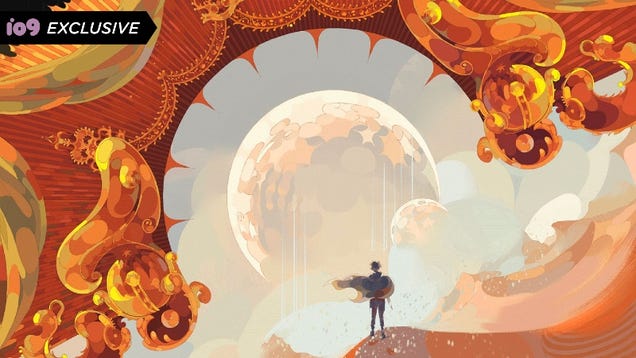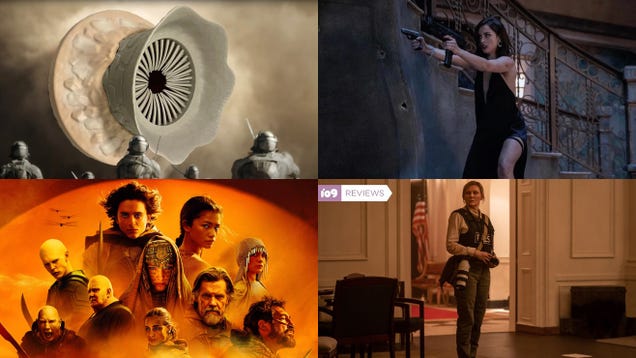
Every time I’ve told people I’ve been reading Frank Herbert’s Dune series, two things happen: 1) I’ll learn what books I can skip, and 2) someone will ask if I’ve seen the Syfy miniseries. Following my experience of watching the baffling disaster that was David Lynch’s vision of Dune, I decided to check out the adaptation that fans consider superior. But were they right?
Released in 2000 as the first official Syfy miniseries, this five-hour version of Dune stars Alec Newman as Paul Atreides, the noble son of a duke (William Hurt) and a Bene Gesserit (Saskia Reeves), who survives an attack on his home and becomes the leader of the people of Arrakis. As House Harkonnen seeks to dominate the planet and seize its spice production, Paul and his allies—including the Fremen warrior Chani (Barbora Kodetová)—work to bring the baron and his family down, changing the fabric of the universe in the process.
The Dune miniseries was a hit for Syfy, airing in over 3 million homes and winning two Primetime Emmy Awards. It later spawned a sequel, Children of Dune, which combined the next two books in Herbert’s sci-fi series. It also ushered in several more Syfy miniseries—including 2003’s backdoor pilot for Battlestar Galactica, which eventually became one of Syfy’s biggest shows. While we wait for Denis Villeneuve’s Dune, the Syfy miniseries remains the most faithful—and some would argue the best—adaptation. That’s definitely true, but that doesn’t mean all of it is good. Let’s take a look at what soars and what flops about Syfy’s Dune.
G/O Media may get a commission
I Liked
It’s Faithful to the Book
You can tell the folks behind the Dune miniseries—namely writer and director John Harrison—really knew and respected what they were adapting. As a result, the movie takes the source material at face value and doesn’t fiddle with it to fit someone else’s vision of what a Dune story should be. That does come with some caveats, which I’ll get into further down. But it was refreshing after watching Lynch’s Dune to see a version that understood what Herbert was trying to say, and worked hard to tell that story to its audience.
The Costumes Are Wild
Costume designer Zuzana Máchová and her team deserve all the money and all the good things in life. These costumes are every level of banana waffles, in the best sense. They are at times both futuristic and retro, by way of the early 1990s, like a combination of Star Wars: The Phantom Menace and Saved by the Bell. I loved every stitch of inexplicable fabric onscreen.
Chani and Lady Jessica
In a 2003 interview with the New York Times about Children of Dune, executive producer Richard P. Rubinstein said the Dune franchise appeals to women because of its strong female characters. You definitely wouldn’t know that watching the Lynch version, which painted its female characters as helpless and subservient. The Dune miniseries vastly improves the storylines of Lady Jessica and Chani, played excellently by Reeves and Kodetová respectively.
We see much more of the agency the characters held in the books. For example, Lady Jessica (not Paul) trains the Fremen in the “weirding way,” and both she and Chani challenge Paul Muad’dib on his views and thirst for power. We see how conflicted they are about supporting him, reflecting our hesitation in whether we want to see him succeed. In some ways, it shows how Dune is a story that is told in spite of Paul, not because of him.
Princess Irulan
There was one major change the miniseries made from the book, and it’s one of the smarter things the adaptation did. The role of Princess Irulan was heavily expanded, giving her a subplot where she cleverly navigates her father’s royal court in search of answers about the Harkonnen attack on House Atreides. Julie Cox handles the role well, portraying Irulan like a shrewd, more grown-up version of the Childlike Empress (no surprise, considering she played her in The NeverEnding Story III). This storyline shows her intelligence, cunning, and ability to play politics with the best of them, something that doesn’t come into play until the later books. Not everything is copacetic—there’s an uncomfortable scene where Irulan (quite obviously) seduces Feyd-Rautha for information—but overall the expanded role manages to give us insight into the Emperor’s world, and shows how everyone within it will do whatever it takes to succeed.
Blue Eyes Effect
The miniseries had a budget of $20 million, which is pretty impressive for a made-for-TV series. But when you’re dealing with a five-hour movie with multiple sets, heavy CGI, and a huge ensemble cast, there aren’t always enough funds to go around. Sometimes you have to get creative, which is what Harrison and his team did with the blue eyes of the Fremen, which are caused by exposure to the spice. According to an article in Tor, instead of trying to add them digitally, all the actors wore UV contact lenses and were filmed with special cameras to catch the light. It wasn’t always perfect: The blue eyes could easily disappear with the wrong camera angle, plus having the eyes glow doesn’t match how they’re described in the books. But overall, it was an impressive and clever way to achieve the effect.
House Harkonnen
One of my biggest problems with Lynch’s Dune adaptation was how it handled House Harkonnen. It turned a powerful and insidious family into a disgusting pile of id, relying on gross-out moments to show their villainy instead of letting their actions speak for themselves. This version takes the opposite approach, giving us a House that’s more Lannister than Bolton, if you’re familiar with Game of Thrones. It presents Baron Harkonnen, played lavishly by Ian McNeice, as a conniving power player—one who believes he’s figured out every contingency to ensure his longterm success, although you can tell there’s always an important detail or two he’s missing because of his arrogance. It makes the Harkonnens feel like a legitimate threat, instead of a disgusting farce.
We Didn’t Like
House Harkonnen
Just because the Harkonnens are more accurately portrayed in the miniseries doesn’t mean they’re perfect. McNeice nails the scheming side of Baron Harkonnen, but falls short when it comes to hitting his darker, more disgusting side. There’s a balance to be found between the gluttony and the greed, and this one failed to find the sweet spot (much like Lynch’s version). László I. Kish as Glossu Rabban is fine, though he isn’t given much to do. And don’t even get me started on Matt Keeslar as Feyd-Rautha. He was a strange choice, always coming across as a bit too normal for someone as sinister and serpentine as Feyd is supposed to be. But I think the silliest part of House Harkonnen is in how their scenes are framed. Every time those characters are onscreen, the director uses Dutch angles. I know it’s to make the audience feel like these characters are throwing things off balance, but all it did was remind me of Battlefield Earth.
Alec Newman as Paul Atreides
If the goal of the miniseries was to make us hate Paul and wish for his ultimate demise, then congratulations—this version of the character is way too much of an asshole. He reminded me of Anakin Skywalker in the Star Wars prequels, and not in a good way. He’s petulant and curt, acting like a child constantly on the verge of a temper tantrum (even though the actor was 26). It didn’t help that he’s also a bit of a creep, at one point ogling Chani’s naked body as she got changed. (Side note: This movie is way hornier than I expected, with lots of breasts and an orgy scene.)
Then, there’s his transition into the Fremen leader Paul Muad’Dib, which kind of just… happens, and it’s only represented by the fact that Newman’s hair gets a little spikier (likely with some serious gel). Don’t get me wrong: Newman is a fine actor and it seemed like he was doing the best he could, but he wasn’t right for the part. He had trouble making us believe Paul’s transition from a young noble into an otherworldly leader who could see the past, present, and future all at once. In the end, he comes across as stubborn, spiteful, and mean, because it fails to represent how much Paul knows what he’s doing to Arrakis is wrong. It’d be one thing if the miniseries was taking a hard stance that Paul is the villain of the story, which is a theory I personally prescribe. But it doesn’t.
Stillsuits
No one should have to wear those on camera.
Some Actors Fell Flat
There are some solid performances in this miniseries, notably the women who play Chani, Lady Jessica, and Princess Irulan, as well as Giancarlo Giannini as Padishah Emperor Shaddam IV. But there are others who turn in some lackluster performances. Zuzana Geislerová fails to give Reverend Mother Gaius Helen Mohiam any form of gravitas, Miroslav Táborský as Count Hasimir Fenring comes and goes like a quiet fart, and I didn’t think there could be a more boring Duncan Idaho but James Watson does it.
However, the biggest offender is William Hurt as Duke Leto Atreides. He seems to be achieving Lost in Space levels of not giving a shit. It gets to the point where his death looks like he’s about to take a nap. I’m probably gonna get some hate for that but you must hear the truth.
More Doesn’t Always Mean Better
Earlier, I praised the miniseries for staying closer to the source material, but that faithfulness comes at a price. In some ways, it stays too close. There are plenty of scenes that work better on paper than on film and could’ve easily been cut from the final product without losing anything—Liet-Kynes’ (Karel Dobrý) death scene is one. It’s a tragic moment that fails to resonate because the movie didn’t succeed in getting us to connect with him before he died. It felt more like a moment they had to keep because “it’s in the book,” rather than for any narrative purpose that works for the story they were telling. Look, I’m all for accurate adaptations, but some things are OK to cut… and this movie needed a trim.
No Pugs
Pugs are canon in Dune now. There should be pugs.
For more, make sure you’re following us on our Instagram @io9dotcom.
Source: gizmodo.com








